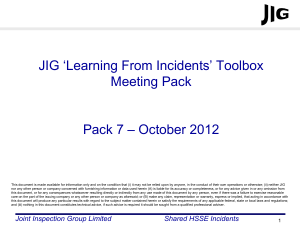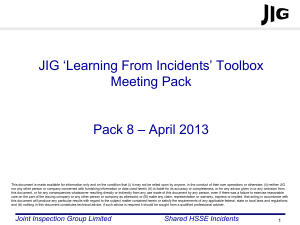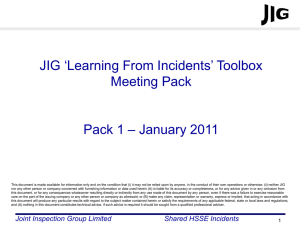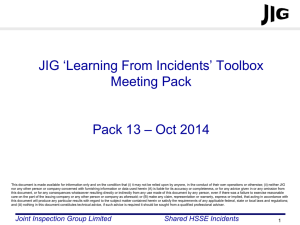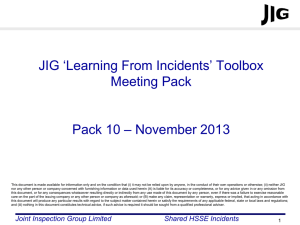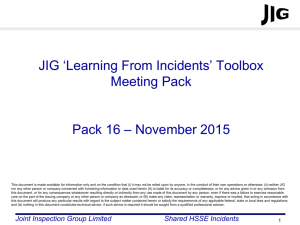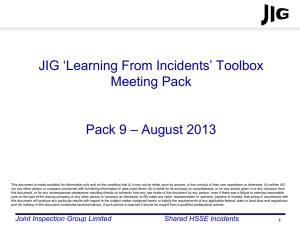Joint Inspection Group Limited Shared HSSE Incidents
advertisement
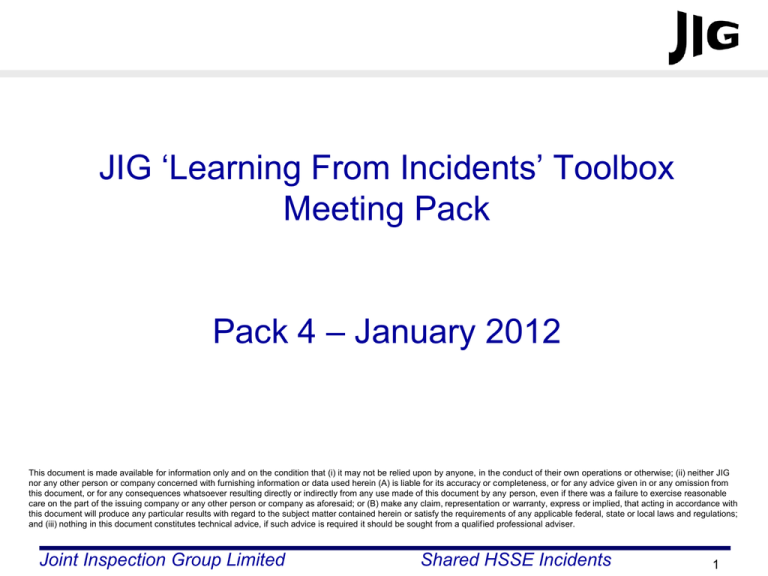
JIG ‘Learning From Incidents’ Toolbox Meeting Pack Pack 4 – January 2012 This document is made available for information only and on the condition that (i) it may not be relied upon by anyone, in the conduct of their own operations or otherwise; (ii) neither JIG nor any other person or company concerned with furnishing information or data used herein (A) is liable for its accuracy or completeness, or for any advice given in or any omission from this document, or for any consequences whatsoever resulting directly or indirectly from any use made of this document by any person, even if there was a failure to exercise reasonable care on the part of the issuing company or any other person or company as aforesaid; or (B) make any claim, representation or warranty, express or implied, that acting in accordance with this document will produce any particular results with regard to the subject matter contained herein or satisfy the requirements of any applicable federal, state or local laws and regulations; and (iii) nothing in this document constitutes technical advice, if such advice is required it should be sought from a qualified professional adviser. Joint Inspection Group Limited Shared HSSE Incidents 1 Learning From Incidents How to use the JIG ‘Learning From Incidents’ Toolbox Meeting Pack • The intention is that these slides promote a healthy, informal dialogue on safety between operators and management. • Slides should be shared with all operators (fuelling operators, depot operators and maintenance technicians) during regular, informal safety meetings. • No need to review every incident in one Toolbox meeting, select 1 or 2 incidents per meeting. • The supervisor or manager should host the meeting to aid the discussion, but should not dominate the discussion. • All published packs can be found on the HSSEMS section of the JIG website (www.jointinspectiongroup.org) Joint Inspection Group Limited Shared HSSE Incidents 2 Learning From Incidents For every incident in this pack, ask yourselves the following questions: • Is there potential for a similar type of incident at our site? • Do our risk assessments identify and adequately reflect these incidents? • Are our prevention measures in place and effective (procedures and practices)? • Are our mitigation measures in place and effective (safety equipment, emergency procedures)? • What can I do personally to prevent this type of incident? Joint Inspection Group Limited Shared HSSE Incidents 3 Aircraft Refuel Adaptor Failure (LFI 2011-10) • Incident Summary - The Operator could not get fuel to flow at the start of a defuelling operation. The aircraft engineers used the aircraft fuel tank boost pumps to start the fuel flow and soon heard a banging noise come from the Hose End Control Valve. The aircraft refuel adaptor cracked upstream of the shut-off valve, which resulted in significant fuel spill as the leak couldn’t be stopped. The path for some of the leaking fuel was onto the engine exhaust pipe. The exhaust pipes were cool at the time of the incident. The crack in the adaptor resulted in the spill Root Causes – • Not following manufactures and other industry guidelines relating to this type of operation Lessons Learnt – • The aircraft manufacturer issued a newsletter in 2002 and again in 2009 warning of refuel adaptor failures when using aircraft boost pumps during defuelling. The aircraft manufacturer recommends locking the HECV open during defuelling to prevent sudden closure and pressure shockwaves. • JIG 1 section 6.6 also requires the HECV to be locked open for defuelling. Can you think of any similar situations that YOU have experienced or witnessed? Did you report it? Joint Inspection Group Limited Shared HSSE Incidents 4 Misfuel (LFI 2011-08) Summary - An aircraft arrived at an Airport and requested fuelling - the grade required was not stated or requested. On arrival at the kerbside dispensers the Operator found a Beech twin engined plane parked in the Jet refuelling position (the airport has two kerbside dispensers – Avgas and Jet) with the fill port caps removed. The pilot asked for the plane to be refuelled. The Operator did not confirm the grade required, nor did he check the plane's grade decals or complete a Fuel Grade Verification Form (FGVF). After putting 8 litres of Jet into the plane’s tank he saw an Avgas grade decal on another fill port and immediately realised his mistake and stopped fuelling. The plane was towed to a safe position without starting the engines and the tank drained and refilled. Close up of fill port showing cap over grade decal Root Causes – • There was no grade verification on taking the order, or when talking to the pilot. No grade decals check took place, and no Fuel Grade Verification Form completed: • The plane was parked in front of the Jet dispenser because the Avgas position was still occupied by the previous customer. • The pilot removed the fill caps because, at another site, they had not been closed properly and had come loose in flight. • The pilot had placed the fill port cap over the red Avgas grade decal, which had been stuck on to a red paint stripe on the plane, so it was camouflaged (see picture). • The kerbside dispensers are operated by grade selective keys. Authorised self-service customers are given a grade selective key, but Operators carry keys for both grades. • The plane was fitted with a large fill port opening which meant that the larger duckbill spout (if fitted) would not have alerted the Operator. Can you think of any similar situations that YOU have experienced or witnessed? Did you report it? Joint Inspection Group Limited Shared HSSE Incidents 5 Drive Away (LFI 2011-01) Incident Summary After completing the fuelling of an A320 the operator was distracted while following the disconnection procedure. He thought that he had disconnected the deck hose to the aircraft. He then closed the deck panel from the ground using another piece of equipment. The deck panel operated the vehicles deck hose anti-lock system, which was now ineffective. The operator then drove away from the aircraft, as the hose was still connected the aircraft coupling point sheered and approximately 5 litres of fuel was spilt from the hose. There was no further damage to the aircraft and the spill was fully contained. Panel Antilock operated by magnet Toolbox Talk Discussion Points - Pin should have stopped panel lowering • If you become distracted whilst following the disconnection procedure what would you do? • During your 360 Walkaround you spot a panel on the elevating work platform that has been left open. Would you try and close it from the ground? Or would you return to the platform to ensure it was safe to close the panel? • The failure of the interlock design played a large part in this incident. Are the interlock systems regularly inspected at your location to ensure they are working correctly? Is everyone aware of the correct operating procedure for interlocks at your location? Can you think of any similar Near Misses that YOU have experienced or witnessed? Did you report it? Joint Inspection Group Limited Shared HSSE Incidents 6 Defective Coupling – Wrist injury (LFI 2010-13) Incident Summary – An operator was starting a fueller loading operation. When locking the coupling of the loading facility hose to the fueller connection, he felt a strong pain in his right wrist. The pain persisted so the next day a medical check was made and a sprain with partial tearing of ligament of his wrist was diagnosed. This resulted in a 2 week absence from work. Root Causes – • Use of defective equipment. An investigation discovered that the couplings were known to have been very hard to manoeuvre for several months/ This recurrent technical problem had not been recorded on a register. • An incomplete preventive maintenance program meant that these items were not inspected. Lessons Learnt – • A suitable method for reporting all technical problems on equipment is needed and these should be recorded in order to identify any deviation and to prepare on time, appropriate corrective/preventive action. • Preventive maintenance programmes must be reviewed to ensure all appropriate site equipment is included. Can you think of any similar situations that YOU have experienced or witnessed? Did you report it? Joint Inspection Group Limited Shared HSSE Incidents 7 Aircraft Incident (LFI 2011-02) Incident Summary – An operator was approaching an Embraer aircraft to perform a fuelling, it was late evening and raining with strong winds. Normally the aircraft used for this flight was an A320. The operator assumed that the aircraft was an A320 and did not check the type aircraft as he approached. The operator attempted to reverse under the wing of the aircraft without a guide person and contacted with the wing of the aircraft with the fueller’s elevating work platform. There was minor damage to both the aircraft and the elevating work platform. Minor damage to aircraft wing Minor damage to the elevation work platform Toolbox Talk Discussion Points• When you approach a stand to refuel an aircraft what do you consider in your Last Minute Risk Assessment? • The operator could not get into the correct refuelling position because of other apron traffic, so decided to try and reverse into position. What would you have done in this situation? Can you think of any similar situations that YOU have experienced or witnessed? Did you report it? Joint Inspection Group Limited Shared HSSE Incidents 8
